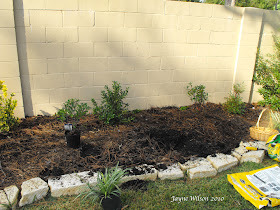Things have finally slowed down a bit, work-wise, so I took advantage this weekend and decided to tackle an area that has been bugging the heck out of me.
While I appreciate the privacy that the concrete block wall between our garden and the road behind our house gives us, let's face it -- it's ugly to look at! It's an eyesore!
I've tried various tactics to hide it, with varying success. Towards the east end of the wall, things are growing well. The Rose of Sharon and Vitex trees took off like gangbusters and are now higher than the wall. The Southern Wax Myrtle in the middle of the bed is doing well too and is about four feet tall and wide at this point.
On the west end of the wall though, nothing can grow. As I showed you back in August, I solved the problem in one spot by creating a little vignette with two containers and some iron trellis.
However, the area next to that, behind the big pine tree as we look at the border from the house, was still just a waste land of concrete block and mulch.
My enthusiam to get working on the area was tempered somewhat as I got my trowel out and started to examine the bed to see if there were any plantable areas. The answer to that question turned out to be a firm "no." The problem? Pine roots - lots of them, and under that, clay - ugh!
After scratching my head to stimulate my thinking cells, I remembered that last time I blogged about the area, someone suggested making a raised bed. Since part of it is already planted, making a full raised bed didn't seem to be an option, so I went for a compromise which may or may not work.
I decided to plant on top of the existing soil and roots, building little "berms" of good garden soil around each plant and then filling in around them with mulch. The idea being that hopefully the new plants have a chance to establish a root system before the pine trees get the idea to extend their roots up in to the new soil.
I opted for simple plantings (read: "cheap"), probably not the most desirable plants, but since the experiement may not work I didn't want to spend $30 on something that I really wanted, only to have it fail.
These little Creeping Fig plants have a rather large blank canvas to fill. I hope they are up to the task. It will be lovely to see green growing up the wall for a change. I only got five of them -- if they look like they might take hold I'll splash out for some more!
I'd never heard of Cleyera, but it should make a decent sized shrub, if it wins the battle with the tree roots. In the front of the bed, I put three Liriope, just for a different color and shape.
Here's the finished bed. It doesn't look too bad, now if those creeping figs would just start creeping and cover that wall!!
Words and photographs by Jayne Wilson, Green and Serene, Jayne's Country Garden.





I'll bet the figs will cover that concrete wall pretty fast, Jayne - and it would be an improvement on the blank concrete.
ReplyDeleteBut don't turn your back on fig ivy! In this post about my garden group the Divas of the Dirt you can see what happened a few years after my friend Mindy planted 2 small 4" pots in her courtyard.
That experience made me decide to keep my fig ivy in containers ;-]
Annie at the Transplantable Rose
Wow - you guys did a great job clearing out Mindy's courtyard. I can see where the creeping fig could overwhelm and possibly damage a house, but I think, on that blank wall, it's the perfect solution (at least I hope so!)
ReplyDeleteIt will be fun to see what happens, Jayne- and it looks like the perfect spot with no windows, roof, housewalls, etc.
ReplyDeleteMaybe you'll need time-lapse photography to show the wall disappearing!
Annie
Those plantings look very nice in that area. It looks like your liriope is variegated. I like that. I have a plain green kind. It spreads a bit, too. If the vine doesn't cover the wall, paint some plants on it.
ReplyDeleteYour new bed looks well for now and if they don't survive, there must be some other plant that will. We'll see the result in spring.
ReplyDelete